White-tailed deer, known scientifically as Odocoileus virginianus, are among the most broadly distributed and widely recognized wildlife species in North America. These graceful animals not only capture our imagination but are also central to both ecology and local economies, playing significant roles in hunting and wildlife observation. Their ability to thrive in diverse habitats from southern Canada to South America makes them fascinating subjects of study and conservation.
Characteristics / Physical Description
White-tailed deer are highly adaptable creatures, with physical characteristics that vary significantly across their range. They typically have reddish-brown coats in summer which transition to a greyer shade in winter. Perhaps their most distinctive feature is the white underside to their tails, which they conspicuously raise as a warning signal when alarmed. Adult males, known as bucks, are recognized by their impressive antlers, which are shed and regrown annually. Females, or does, are generally smaller and lack antlers.
Taxonomy and Classification
Belonging to the family Cervidae, white-tailed deer are part of the order Artiodactyla, which includes hoofed mammals with an even number of toes. They are one of the many species within the genus Odocoileus. This classification highlights their evolutionary relationships with other deer species across the Americas.
Behavior and Social Structure
White-tailed deer are generally crepuscular, being most active during dawn and dusk. Outside of the breeding season, known as the rut, bucks tend to form bachelor groups, while does and their fawns group together in maternal herds. Their behavior can shift dramatically during the rut, when bucks become more territorial and aggressive as they compete for mates.
Habitat and Distribution
These deer are highly adaptable and occupy a range of habitats including forests, farmlands, brushy areas, and suburban neighborhoods. Their flexibility in diet and habitat preferences has enabled them to thrive across a vast geographic range.
Diet and Feeding Habits
As herbivores, white-tailed deer have a diet consisting of leaves, twigs, fruits, and nuts. They are known for their ability to adapt their feeding habits to the seasons, taking advantage of the most readily available food sources throughout the year.
Breeding and Reproduction
The reproductive cycle of the white-tailed deer is fascinating, with mating typically occurring in November. Does usually give birth to one to three fawns in the spring after a gestation period of about 200 days. Fawns are born with white spots that help camouflage them in the wild, which they lose as they grow older.
Relationship with Humans
White-tailed deer have a significant impact on human activities, influencing hunting traditions, agriculture, and vehicle collisions. In many areas, they are considered game animals, with regulated hunting helping to control their populations and prevent overgrazing and crop damage.
Evolutionary History
The evolutionary history of white-tailed deer is marked by their remarkable adaptability and resilience. They have occupied North America for thousands of years, adapting to changes in climate and habitat and surviving periods of intense hunting and habitat loss.
Use as Research Animals
In scientific contexts, white-tailed deer have been studied extensively to understand their behavior, ecology, and interactions with other species. They serve as important models for conservation biology, particularly in studies related to population dynamics and the effects of human encroachment on wildlife habitats.

